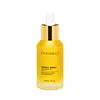What's inside
What's inside
 Key Ingredients
Key Ingredients

 Benefits
Benefits

 Concerns
Concerns

 Ingredients Side-by-side
Ingredients Side-by-side

Sambucus Nigra Seed Oil
Rosa Canina Seed Oil
EmollientCrambe Abyssinica Seed Oil
Skin ConditioningSqualane
EmollientTocopheryl Acetate
AntioxidantSalvia Hispanica Seed Oil
MoisturisingRibes Nigrum Seed Oil
EmollientRubus Chamaemorus Seed Oil
Skin ConditioningVaccinium Vitis-Idaea Seed Oil
AntioxidantPalmitoyl Hexapeptide-12
Skin ConditioningPalmitoyl Tetrapeptide-7
Skin ConditioningPalmitoyl Tripeptide-1
Skin ConditioningLinoleic Acid
CleansingLinolenic Acid
CleansingTocopherol
AntioxidantLithospermum Erythrorhizon Root Extract
Skin ConditioningRosmarinus Officinalis Leaf Extract
AntimicrobialHelianthus Annuus Seed Oil
EmollientCaprylic/Capric Triglyceride
MaskingPentaerythrityl Tetraisostearate
EmollientPropylene Carbonate
SolventStearalkonium Hectorite
Gel FormingParfum
MaskingCitral
PerfumingLimonene
PerfumingLinalool
PerfumingSambucus Nigra Seed Oil, Rosa Canina Seed Oil, Crambe Abyssinica Seed Oil, Squalane, Tocopheryl Acetate, Salvia Hispanica Seed Oil, Ribes Nigrum Seed Oil, Rubus Chamaemorus Seed Oil, Vaccinium Vitis-Idaea Seed Oil, Palmitoyl Hexapeptide-12, Palmitoyl Tetrapeptide-7, Palmitoyl Tripeptide-1, Linoleic Acid, Linolenic Acid, Tocopherol, Lithospermum Erythrorhizon Root Extract, Rosmarinus Officinalis Leaf Extract, Helianthus Annuus Seed Oil, Caprylic/Capric Triglyceride, Pentaerythrityl Tetraisostearate, Propylene Carbonate, Stearalkonium Hectorite, Parfum, Citral, Limonene, Linalool
Cocoglycerides
EmollientCaprylic/Capric Triglyceride
MaskingOctyldodecanol
EmollientCocos Nucifera Oil
MaskingCrambe Abyssinica Seed Oil
Skin ConditioningEthylcellulose
Oenothera Biennis Oil
EmollientHelianthus Annuus Seed Oil
EmollientHibiscus Sabdariffa Seed Oil
EmollientRosa Moschata Seed Oil
EmollientHoney Extract
HumectantPropolis Extract
Skin ConditioningRoyal Jelly Extract
Skin ConditioningHippophae Rhamnoides Oil
EmollientHippophae Rhamnoides Seed Oil
Skin ProtectingHelianthus Annuus Extract
EmollientCitrus Aurantium Bergamia Fruit Oil
MaskingTocopherol
AntioxidantOryza Sativa Bran Extract
Skin ConditioningWater
Skin ConditioningRosmarinus Officinalis Leaf Extract
AntimicrobialAroma
Limonene
PerfumingLinalool
PerfumingCocoglycerides, Caprylic/Capric Triglyceride, Octyldodecanol, Cocos Nucifera Oil, Crambe Abyssinica Seed Oil, Ethylcellulose, Oenothera Biennis Oil, Helianthus Annuus Seed Oil, Hibiscus Sabdariffa Seed Oil, Rosa Moschata Seed Oil, Honey Extract, Propolis Extract, Royal Jelly Extract, Hippophae Rhamnoides Oil, Hippophae Rhamnoides Seed Oil, Helianthus Annuus Extract, Citrus Aurantium Bergamia Fruit Oil, Tocopherol, Oryza Sativa Bran Extract, Water, Rosmarinus Officinalis Leaf Extract, Aroma, Limonene, Linalool
 Reviews
Reviews

Ingredients Explained
These ingredients are found in both products.
Ingredients higher up in an ingredient list are typically present in a larger amount.
This ingredient is an emollient, solvent, and texture enhancer. It is considered a skin-softener by helping the skin prevent moisture loss.
It helps thicken a product's formula and makes it easier to spread by dissolving clumping compounds.
Caprylic Triglyceride is made by combining glycerin with coconut oil, forming a clear liquid.
While there is an assumption Caprylic Triglyceride can clog pores due to it being derived from coconut oil, there is no research supporting this.
Learn more about Caprylic/Capric TriglycerideCrambe Abyssinica Seed Oil is an oil and isn't fungal acne safe.
Helianthus Annuus Seed Oil is the oil derived from the seeds of a Sunflower. Sunflower seed oil is non-fragrant. It is an emollient, meaning it helps to soften the skin.
Sunflower seed oil contains many fatty acids. The fatty acids found in sunflower seeds include (from highest amount to least): linoleic acid, myristic acid, palmitic acid, stearic acid, arachidic acid, oleic acid, and linolenic acid.
These fatty acids help the skin create ceramides. Ceramides play a role in repairing the skin barrier.
Helianthus Annuus Seed Oil helps moisturize the skin. This in turn helps the skin look more rejuvenated and smoother.
Sunflowers are rich in vitamin E.
Historians believe Indigenous cultures of North America domesticated sunflowers before corn. Thus they relied on sunflower oil for a variety of uses. One such use is moisturizing skin and hair.
Sunflower seed oil may not be fungal acne safe. We recommend speaking with a professional if you have any concerns.
Learn more about Helianthus Annuus Seed OilLimonene is a fragrance that adds scent and taste to a formulation.
It's found in the peel oil of citrus fruits and other plants such as lavender and eucalyptus. The scent of limonene is generally described as "sweet citrus".
Limonene acts as an antioxidant, meaning it helps neutralize free radicals.
When exposed to air, oxidized limonene may sensitize the skin. Because of this, limonene is often avoided by people with sensitive skin.
The term 'fragrance' is not regulated in many countries. In many cases, it is up to the brand to define this term. For instance, many brands choose to label themselves as "fragrance-free" because they are not using synthetic fragrances. However, their products may still contain ingredients such as essential oils that are considered a fragrance.
Learn more about LimoneneLinalool is a fragrance and helps add scent to products. It's derived from common plants such as cinnamon, mint, citrus, and lavender.
Like Limonene, this ingredient oxidizes when exposed to air. Oxidized linalool can cause allergies and skin sensitivity.
This ingredient has a scent that is floral, spicy tropical, and citrus-like.
Learn more about LinaloolRosmarinus Officinalis Leaf Extract comes from rosemary. Rosemary is native to the Mediterranean.
While Rosmarinus Officinalis Leaf Oil can be volatile due to its fragrant properties, the fragrance components are usually removed in the leaf extract.
Rosemary Leaf Extract contains many antioxidants such as rosmarinic acid and caffeic acid. Rosemarinic acid, a compound found in rosemary leaf, has been found to help soothe skin conditions such as eczema and acne.
Learn more about Rosmarinus Officinalis Leaf ExtractTocopherol (also known as Vitamin E) is a common antioxidant used to help protect the skin from free-radicals and strengthen the skin barrier. It's also fat soluble - this means our skin is great at absorbing it.
Vitamin E also helps keep your natural skin lipids healthy. Your lipid skin barrier naturally consists of lipids, ceramides, and fatty acids. Vitamin E offers extra protection for your skin’s lipid barrier, keeping your skin healthy and nourished.
Another benefit is a bit of UV protection. Vitamin E helps reduce the damage caused by UVB rays. (It should not replace your sunscreen). Combining it with Vitamin C can decrease sunburned cells and hyperpigmentation after UV exposure.
You might have noticed Vitamin E + C often paired together. This is because it is great at stabilizing Vitamin C. Using the two together helps increase the effectiveness of both ingredients.
There are often claims that Vitamin E can reduce/prevent scarring, but these claims haven't been confirmed by scientific research.
Learn more about Tocopherol